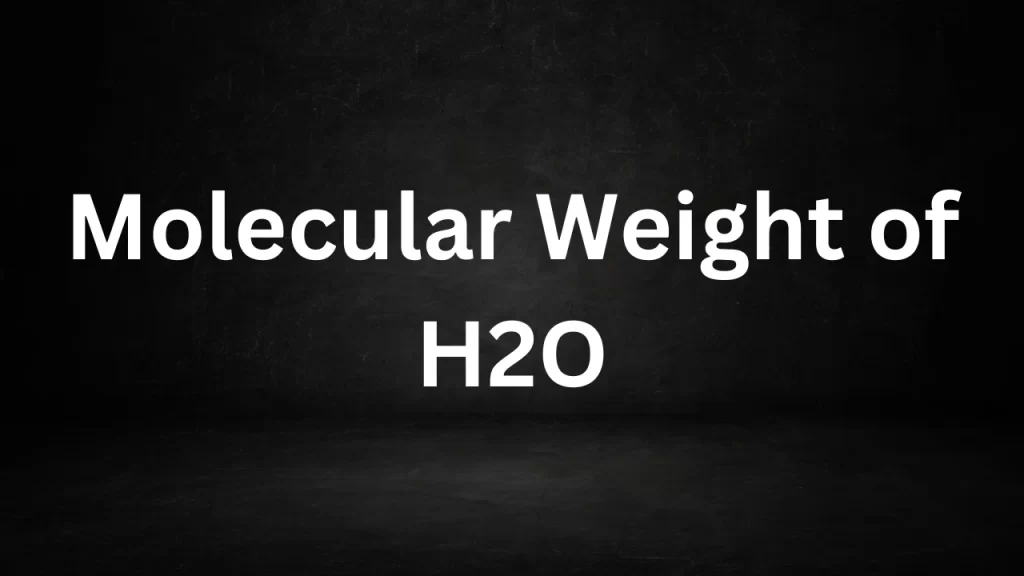Molecular Weight of H2O: Water, Earth’s most abundant and vital substance, consists of molecules possessing a distinct molecular weight critical for all life forms.
Understanding the molecular weight of water, represented as H2O, is fundamental not only in chemistry but also in various scientific and practical applications.
This article delves into the concept of H2O’s molecular weight, its calculation, and its importance across various fields of science and industry.

Molecular Weight of H2O
The Composition of Water:
Water, with the chemical formula H2O, consists of two hydrogen atoms (H) covalently bonded to a single oxygen atom (O). These atoms come together to form a water molecule. This molecular arrangement gives water its unique properties, such as its ability to dissolve a wide range of substances and its high heat capacity.
Calculating the Molecular Weight of H2O:
The molecular weight of a substance is defined as the mass of one mole of that substance, expressed in grams per mole (g/mol). To calculate the molecular weight of H2O, we consider the atomic masses of its constituent elements, hydrogen (H) and oxygen (O).
- The atomic mass of hydrogen (H) is approximately 1.01 g/mol.
- The atomic mass of oxygen (O) is approximately 16.00 g/mol.
To find the mole weight of H2O, we add the atomic masses of two hydrogen atoms and one oxygen atom:
Mole Weight of H2O (g/mol) = (2 × Atomic Mass of Hydrogen) + (1 × Atomic Mass of Oxygen)
Mole Weight of H2O ≈ (2 × 1.01 g/mol) + (1 × 16.00 g/mol) ≈ 18.02 g/mol
So, the mole weight of H2O (water) is approximately 18.02 g/mol.
Significance of Molecular Weight in Chemistry:
- Stoichiometry: Mole weight is crucial in stoichiometry, which involves determining the quantities of reactants and products in chemical reactions.
- Molarity: In chemistry, molarity (M) is a measure of the concentration of a substance in a solution. Molecular weight serves as a key factor in calculating molarity, a measure expressed as moles per liter (mol/L).
- Chemical Equations: Mole weight plays a vital role in balancing chemical equations to ensure the conservation of mass.
Real-World Applications:
- Laboratory Work: Chemists and researchers use the molecular weight of substances like water in laboratory experiments and analyses.
- Pharmaceuticals: Molecular weight is critical in pharmaceuticals for dosage calculations and drug formulation.
- Environmental Science: Understanding the molecular weight of water is essential in environmental science for assessing water quality and pollutant concentrations.
Conclusion:
The mole weight of H2O, approximately 18.02 g/mol, is a fundamental concept in chemistry and has broad applications in various scientific and practical fields. Whether in the laboratory, pharmaceutical industry, or environmental science, knowing the molecular weight of water is essential for precise measurements and calculations. It is a reminder of the simple yet profound principles that govern the behavior of substances at the molecular level, shaping our understanding of the world around us.
Read More
- Molecular Weight Of K2Cr2O7
- Molecular Weight Of Phosphorus
- Molecular Weight Of SO2
- Molecular Weight of Na2CO3
- Molecular Mass Of Sodium
Frequently Asked Questions (FAQs) on Molecular Weight of H2O
Q1: What is the molecular weight of H2O (water)?
A1: The mole weight of H2O, which is water, is approximately 18.02 grams per mole (g/mol). This value is calculated by summing the atomic masses of two hydrogen atoms (H) and one oxygen atom (O) in a water molecule.
Q2: Why is knowing the molecular weight of H2O important?
A2: Understanding the mole weight of H2O is crucial in various scientific and practical applications. It is used in chemistry for stoichiometry, molarity calculations, and balancing chemical equations. In fields like environmental science and pharmaceuticals, it helps in precise measurements and dosage calculations.
Q3: Does the molecular weight of H2O change with temperature or pressure?
A3: The molecular weight of H2O remains constant regardless of temperature or pressure. It is a fixed value based on the atomic masses of hydrogen and oxygen.
Q4: How is the molecular weight of H2O calculated?
A4: The mole weight of H2O is calculated by adding the atomic masses of its constituent elements. The atomic mass of hydrogen (H) is approximately 1.01 g/mol, and the atomic mass of oxygen (O) is approximately 16.00 g/mol. Therefore, for water (H2O), it is approximately 18.02 g/mol.
Q5: Can the molecular weight of H2O vary in different types of water?
A5: The mole weight of H2O is the same for all types of water, including distilled water, tap water, and seawater. It is a constant value based on the chemical composition of water, which consists of two hydrogen atoms and one oxygen atom per molecule.
